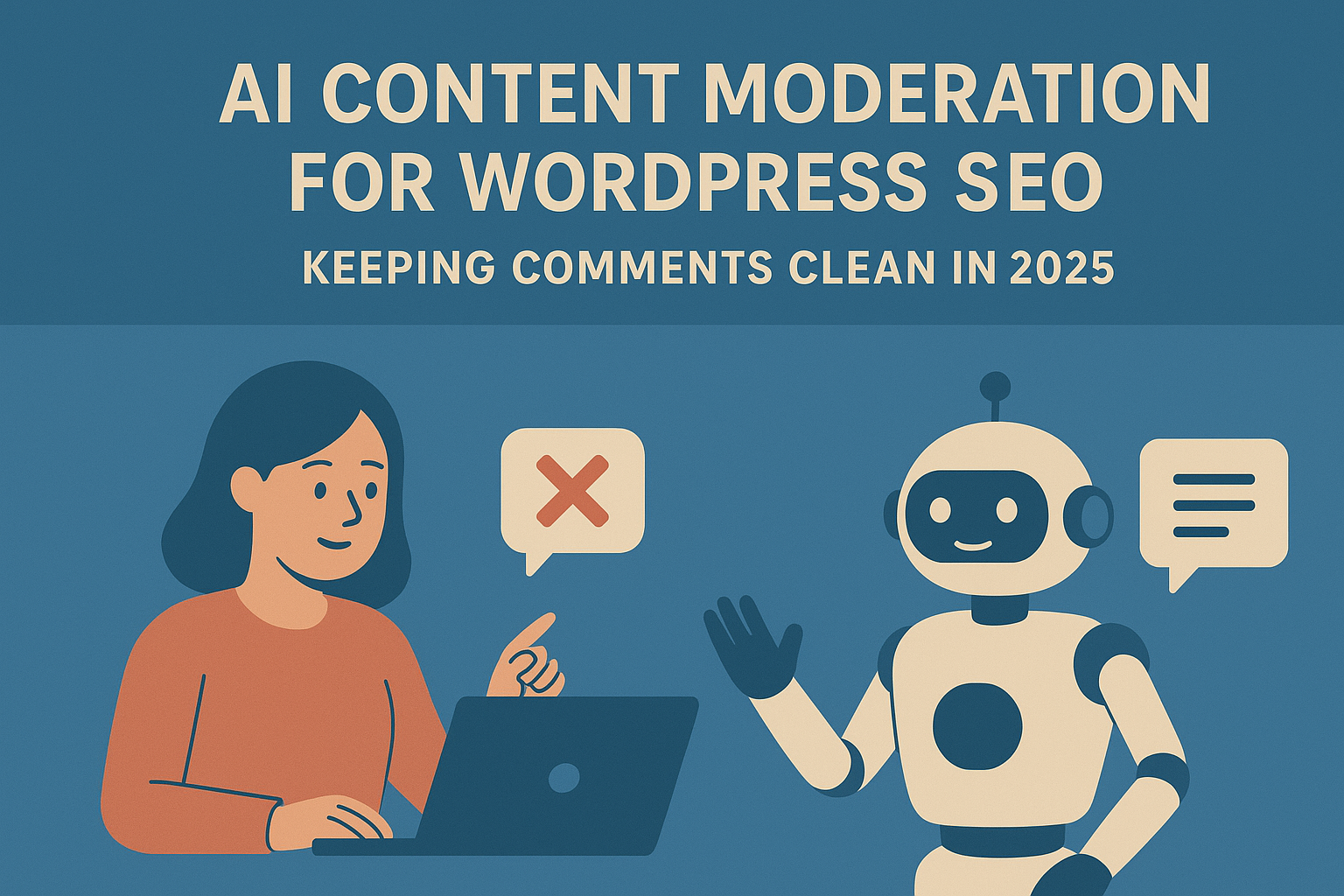AI Content Moderation for WordPress: Keeping Comments Clean in 2025
Introduction
WordPress comments can be a double-edged sword — they foster community, but they also attract spam, hate speech, and toxic behavior. In 2025, artificial intelligence has become powerful enough to automate moderation intelligently, helping you keep your site’s discussion clean and safe without silencing genuine users. Let’s explore how AI content moderation works for WordPress, the best tools and APIs available, and how to implement it ethically.
🧠 What Is AI Content Moderation?
AI content moderation uses machine learning models trained to identify harmful or unwanted content — from spam and profanity to harassment or hate speech. These models analyze the text (and even media) to flag or remove comments that violate your site’s rules. Unlike traditional keyword filters, modern AI models understand context, tone, and intent.
For example, OpenAI’s Moderation API or Google’s Perspective API can detect subtle forms of toxicity or self-harm language that simple filters miss.
🧩 Why WordPress Needs AI Moderation in 2025
- 💬 Massive volume: Large blogs and news sites get thousands of comments daily — manual review isn’t scalable.
- 🚫 Smarter spammers: AI-generated spam comments now look human; traditional anti-spam filters struggle.
- 🧑⚖️ Compliance: Regulations and community standards increasingly demand active content moderation.
- 🌍 Multilingual detection: New AI models handle multiple languages, essential for global WordPress sites.
⚙️ Example: Using the OpenAI Moderation API in WordPress
This example shows how to integrate an AI moderation check into WordPress comments. Before a comment is approved, it’s analyzed using the OpenAI Moderation API.
// functions.php or a small plugin
add_filter('pre_comment_approved', 'ai_moderate_comment_before_approve', 10, 2);
function ai_moderate_comment_before_approve($approved, $commentdata) {
$comment_text = $commentdata['comment_content'];
$api_key = getenv('OPENAI_API_KEY');
if (!$api_key) return $approved; // fallback if not configured
$response = wp_remote_post('https://api.openai.com/v1/moderations', [
'headers' => [
'Authorization' => 'Bearer ' . $api_key,
'Content-Type' => 'application/json'
],
'body' => json_encode(['model' => 'omni-moderation-latest', 'input' => $comment_text]),
'timeout' => 15
]);
if (is_wp_error($response)) return $approved;
$body = json_decode(wp_remote_retrieve_body($response), true);
$flagged = $body['results'][0]['flagged'] ?? false;
if ($flagged) {
// Store in meta for review
add_comment_meta($commentdata['comment_post_ID'], 'ai_flagged_comment', $comment_text);
return '0'; // Hold for moderation
}
return $approved;
}
🟡 Result: If the AI flags a comment as harmful, it’s held for human review instead of being automatically published.
🧰 Other AI APIs You Can Use
- Perspective API (by Google): Scores toxicity, insult, threat, and identity attack levels.
- Hugging Face Transformers: Host your own model for complete control and privacy.
- Azure Content Moderator: Supports text, image, and video scanning.
- OpenAI GPT Models: Can classify and summarize moderation context in more nuanced ways.
🔐 Privacy & Ethics Considerations
- 🧾 Transparency: Inform users that AI moderation is used and explain why.
- 📉 False positives: AI can make mistakes — always allow for human review of flagged comments.
- 🌍 Bias detection: Some models may misinterpret cultural expressions — monitor regularly.
- 🔒 Data security: Don’t send sensitive user data to third-party APIs without consent.
📊 Dashboard: Reviewing Flagged Comments
You can extend the example plugin with a custom admin page that lists all AI-flagged comments for review. Use WP_List_Table or the built-in edit-comments.php with a meta query to show “AI-flagged” ones.
function ai_flagged_comments_admin_menu() {
add_menu_page('AI Moderation', 'AI Moderation', 'moderate_comments', 'ai-moderation', 'ai_render_flagged_comments');
}
add_action('admin_menu', 'ai_flagged_comments_admin_menu');
function ai_render_flagged_comments() {
$comments = get_comments(['meta_key' => 'ai_flagged_comment', 'number' => 50]);
echo '<h2>AI-Flagged Comments</h2>';
foreach ($comments as $comment) {
echo '<p><strong>' . esc_html($comment->comment_author) . '</strong>: ' . esc_html($comment->comment_content) . '</p>';
}
}
🧩 Combine with Existing Tools
AI moderation works best when paired with classic WordPress tools:
- 🧱 Akismet: Still valuable for spam detection.
- 🛡️ Antispam Bee: Lightweight and privacy-focused plugin.
- 🧭 Custom AI Layer: Combine keyword filters + AI API checks for maximum accuracy.
💡 Bonus: Comment Scoring Example
Instead of rejecting comments outright, assign them a “toxicity score” and display it in the admin dashboard:
add_action('comment_post', 'ai_score_comment_toxicity', 10, 2);
function ai_score_comment_toxicity($comment_ID, $approved) {
$comment = get_comment($comment_ID);
$text = $comment->comment_content;
// Example with Perspective API
$response = wp_remote_post('https://commentanalyzer.googleapis.com/v1alpha1/comments:analyze?key=YOUR_API_KEY', [
'headers' => ['Content-Type' => 'application/json'],
'body' => json_encode([
'comment' => ['text' => $text],
'languages' => ['en'],
'requestedAttributes' => ['TOXICITY' => new stdClass()]
])
]);
$data = json_decode(wp_remote_retrieve_body($response), true);
$score = $data['attributeScores']['TOXICITY']['summaryScore']['value'] ?? 0;
add_comment_meta($comment_ID, 'toxicity_score', $score);
}
✅ This approach lets you visualize which comments might need review rather than auto-blocking them.
📈 Best Practices for 2025
- Train your model (or fine-tune prompts) using your own comment history.
- Balance automation and fairness — don’t fully auto-delete unless confidence is high.
- Log all moderation actions for transparency and appeals.
- Regularly audit false positives and adjust thresholds.
Conclusion
AI-powered moderation in WordPress is no longer futuristic — it’s essential. Whether you’re managing a large publication or a small community site, integrating AI can save hours, improve civility, and ensure compliance with online safety standards. By combining automation with ethical review, your WordPress comment section can stay clean, inclusive, and genuinely engaging in 2025 and beyond.
Next step: Try connecting the OpenAI Moderation API to your comment workflow and analyze the first 100 comments — you’ll be surprised how much unwanted content it catches.
Related reading:




